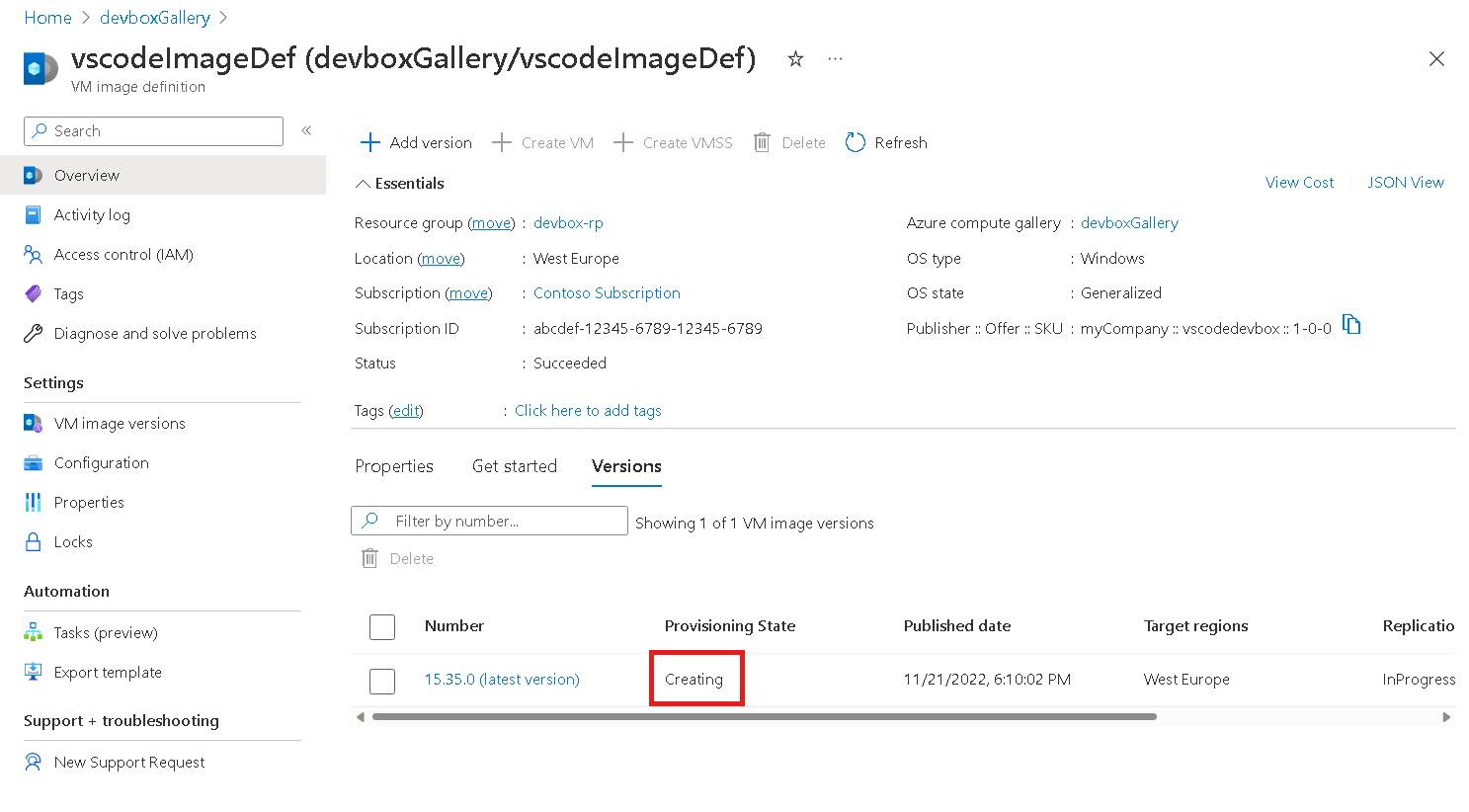你当前正在访问 Microsoft Azure Global Edition 技术文档网站。 如果需要访问由世纪互联运营的 Microsoft Azure 中国技术文档网站,请访问 https://docs.azure.cn。
本文介绍如何使用 Azure VM 映像生成器模板在 Azure 计算库中创建自定义 VM 映像并将其全局分发。 然后,可以使用映像在 Microsoft Dev Box 中创建开发框。
标准化 VM 映像可以通过包含预定义的安全性、配置和软件,帮助您确保开发环境的部署一致性。 但手动设置映像管道非常耗时且复杂,创建自定义虚拟机(VM)映像可能困难且不可靠。
Azure VM 映像生成器是基于 HashiCorp Packer 的托管服务,简化了为开发框创建和生成 VM 映像的过程。 本文中的映像生成器模板包括安装 Visual Studio Code 和 Chocolatey 的自定义步骤。
VM 映像生成器可以:
- 抽象化手动步骤或复杂的工具和流程,并隐藏特定于 Azure 的需求。 例如,通过运行
sysprep通用化映像,但允许高级用户替代它。 - 使用现有的映像生成管道。 可以从管道调用 VM 映像生成器或使用 Azure Pipelines 中的 Azure VM 映像生成器服务任务。
- 从不同来源收集自定义数据,这样您就不必再自行收集。
- 与 Azure 计算库集成,为全局分发、复制、版本控制和缩放创建映像管理系统。 可以将映像作为虚拟硬盘和托管映像分发,而无需重新生成它。
重要说明
Microsoft Dev Box 只支持使用受信任的启动安全类型的映像。
Prerequisites
本文中的示例使用 Azure PowerShell。 还可以使用 Azure CLI。
| 类别 | 要求 |
|---|---|
| 工具和权限 | 拥有 所有者 或 参与者 权限的 Azure 资源组。 |
| Tools | 已安装 Azure PowerShell 6.0 或更高版本。 有关说明,请参阅 在 Windows 上安装 Azure PowerShell。 |
设置工具和角色
如需设置工具和角色,请执行以下操作:
- 安装必要的 Azure PowerShell 模块。
- 为多次使用的信息设置变量。
- 注册必要的 Azure 资源提供程序。
- 为资源组创建用户标识,并为其分配一个允许分发映像的角色。
安装 PowerShell 模块
运行以下命令安装必要的 PowerShell 模块:
'Az.ImageBuilder', 'Az.ManagedServiceIdentity' | ForEach-Object {Install-Module -Name $_ -AllowPrerelease}
对有关不受信任的存储库的提示做出 Y 响应。
设置变量
创建变量以存储多次使用的信息。 运行以下代码,将其 <resource-group> 替换为资源组名称和 <location> 要使用的 Azure 区域。
# Get existing context
$currentAzContext = Get-AzContext
# Get your current subscription ID
$subscriptionID=$currentAzContext.Subscription.Id
# Destination image resource group
$imageResourceGroup="<resource-group>"
# Location
$location="<location>"
# Image distribution metadata reference name
$runOutputName="aibCustWinManImg01"
# Image template name
$imageTemplateName="vscodeWinTemplate"
注册 Azure 资源提供程序
若要使用 VM 映像生成器,必须注册以下 Azure 资源提供程序:
Microsoft.VirtualMachineImagesMicrosoft.ComputeMicrosoft.NetworkMicrosoft.StorageMicrosoft.KeyVaultMicrosoft.ContainerInstance
运行以下命令检查提供程序注册:
Get-AzResourceProvider -ProviderNamespace "Microsoft.VirtualMachineImages", "Microsoft.Compute", "Microsoft.Network", "Microsoft.Storage", "Microsoft.KeyVault", "Microsoft.ContainerInstance" | Format-table -Property ProviderNamespace,RegistrationState如果任何提供程序注册未返回
Registered,请通过运行命令Register-AzResourceProvider来注册提供程序。 以下示例注册Microsoft.VirtualMachineImages资源提供程序。Register-AzResourceProvider -ProviderNamespace Microsoft.VirtualMachineImages
创建和分配用户标识
创建允许分发映像的 Azure 角色定义。 然后为资源组创建用户分配的标识,并将角色分配给用户标识。 VM 映像生成器使用用户标识将映像存储在 Azure 计算库中。
运行以下代码来创建 Azure 角色定义和用户标识。
# Set up a unique role definition name $timeInt=$(get-date -UFormat "%s") $imageRoleDefName="Azure Image Builder Image Def"+$timeInt $identityName="aibIdentity"+$timeInt # Create an identity New-AzUserAssignedIdentity -ResourceGroupName $imageResourceGroup -Name $identityName -Location $location $identityNameResourceId=$(Get-AzUserAssignedIdentity -ResourceGroupName $imageResourceGroup -Name $identityName).Id $identityNamePrincipalId=$(Get-AzUserAssignedIdentity -ResourceGroupName $imageResourceGroup -Name $identityName).PrincipalId运行以下代码下载 Azure 角色定义模板,该模板允许分发映像、使用参数更新模板,并将角色分配给用户标识。
$aibRoleImageCreationUrl="https://raw.githubusercontent.com/azure/azvmimagebuilder/master/solutions/12_Creating_AIB_Security_Roles/aibRoleImageCreation.json" $aibRoleImageCreationPath = "aibRoleImageCreation.json" # Download the configuration Invoke-WebRequest -Uri $aibRoleImageCreationUrl -OutFile $aibRoleImageCreationPath -UseBasicParsing ((Get-Content -path $aibRoleImageCreationPath -Raw) -replace '<subscriptionID>',$subscriptionID) | Set-Content -Path $aibRoleImageCreationPath ((Get-Content -path $aibRoleImageCreationPath -Raw) -replace '<rgName>', $imageResourceGroup) | Set-Content -Path $aibRoleImageCreationPath ((Get-Content -path $aibRoleImageCreationPath -Raw) -replace 'Azure Image Builder Service Image Creation Role', $imageRoleDefName) | Set-Content -Path $aibRoleImageCreationPath # Create a role definition New-AzRoleDefinition -InputFile ./aibRoleImageCreation.json # Grant the role definition to the VM Image Builder service principal New-AzRoleAssignment -ObjectId $identityNamePrincipalId -RoleDefinitionName $imageRoleDefName -Scope "/subscriptions/$subscriptionID/resourceGroups/$imageResourceGroup"
创建图库和 VM 映像生成器模板
若要将 VM 映像生成器与 Azure 计算库配合使用,需要一个库和一个映像定义。 以下步骤创建新的库和映像定义并自定义 VM 映像生成器模板。
运行以下命令以创建新库和映像定义,该定义具有 Windows 365 映像所需的受信任启动安全类型。
# Gallery name $galleryName= "devboxGallery" # Image definition name $imageDefName ="vscodeImageDef" # Second replication region $replRegion2="eastus" # Create the gallery New-AzGallery -GalleryName $galleryName -ResourceGroupName $imageResourceGroup -Location $location $SecurityType = @{Name='SecurityType';Value='TrustedLaunch'} $features = @($SecurityType) # Create the image definition New-AzGalleryImageDefinition -GalleryName $galleryName -ResourceGroupName $imageResourceGroup -Location $location -Name $imageDefName -OsState generalized -OsType Windows -Publisher 'myCompany' -Offer 'vscodebox' -Sku '1-0-0' -Feature $features -HyperVGeneration "V2"将 VM 映像生成器的以下 Azure 资源管理器模板复制并粘贴到新文件中。 将文件保存到 c:\temp\mytemplate.js等位置,然后关闭该文件。
该模板定义应用的源映像和自定义项,安装 Chocolatey 和 Visual Studio Code,并指示映像分发位置。
{ "$schema": "http://schema.management.azure.com/schemas/2015-01-01/deploymentTemplate.json#", "contentVersion": "1.0.0.0", "parameters": { "imageTemplateName": { "type": "string" }, "api-version": { "type": "string" }, "svclocation": { "type": "string" } }, "variables": {}, "resources": [ { "name": "[parameters('imageTemplateName')]", "type": "Microsoft.VirtualMachineImages/imageTemplates", "apiVersion": "[parameters('api-version')]", "location": "[parameters('svclocation')]", "dependsOn": [], "tags": { "imagebuilderTemplate": "win11multi", "userIdentity": "enabled" }, "identity": { "type": "UserAssigned", "userAssignedIdentities": { "<imgBuilderId>": {} } }, "properties": { "buildTimeoutInMinutes": 100, "vmProfile": { "vmSize": "Standard_DS2_v2", "osDiskSizeGB": 127 }, "source": { "type": "PlatformImage", "publisher": "MicrosoftWindowsDesktop", "offer": "Windows-11", "sku": "win11-21h2-ent", "version": "latest" }, "customize": [ { "type": "PowerShell", "name": "Install Choco and VS Code", "inline": [ "Set-ExecutionPolicy Bypass -Scope Process -Force; [System.Net.ServicePointManager]::SecurityProtocol = [System.Net.ServicePointManager]::SecurityProtocol -bor 3072; iex ((New-Object System.Net.WebClient).DownloadString('https://community.chocolatey.org/install.ps1'))", "choco install -y vscode" ] } ], "distribute": [ { "type": "SharedImage", "galleryImageId": "/subscriptions/<subscriptionID>/resourceGroups/<rgName>/providers/Microsoft.Compute/galleries/<sharedImageGalName>/images/<imageDefName>", "runOutputName": "<runOutputName>", "artifactTags": { "source": "azureVmImageBuilder", "baseosimg": "win11multi" }, "replicationRegions": [ "<region1>", "<region2>" ] } ] } } ] }通过运行以下代码使用设置配置新模板,并将
<template-location>替换为模板文件位置和名称。$templateFilePath = "<template-location>" (Get-Content -path $templateFilePath -Raw ) -replace '<subscriptionID>',$subscriptionID | Set-Content -Path $templateFilePath (Get-Content -path $templateFilePath -Raw ) -replace '<rgName>',$imageResourceGroup | Set-Content -Path $templateFilePath (Get-Content -path $templateFilePath -Raw ) -replace '<runOutputName>',$runOutputName | Set-Content -Path $templateFilePath (Get-Content -path $templateFilePath -Raw ) -replace '<imageDefName>',$imageDefName | Set-Content -Path $templateFilePath (Get-Content -path $templateFilePath -Raw ) -replace '<sharedImageGalName>',$galleryName| Set-Content -Path $templateFilePath (Get-Content -path $templateFilePath -Raw ) -replace '<region1>',$location | Set-Content -Path $templateFilePath (Get-Content -path $templateFilePath -Raw ) -replace '<region2>',$replRegion2 | Set-Content -Path $templateFilePath ((Get-Content -path $templateFilePath -Raw) -replace '<imgBuilderId>',$identityNameResourceId) | Set-Content -Path $templateFilePath
生成和查看映像
将自定义模板提交到 VM 映像生成器服务并生成映像。
运行以下命令,将模板提交到服务。 该命令下载任何依赖项目(如脚本),并将其存储在前缀为
IT_的过渡资源组中。New-AzResourceGroupDeployment -ResourceGroupName $imageResourceGroup -TemplateFile $templateFilePath -Api-Version "2020-02-14" -imageTemplateName $imageTemplateName -svclocation $location通过在模板上调用
Run操作来生成镜像。 在确认提示符下,输入 Y。YesInvoke-AzResourceAction -ResourceName $imageTemplateName -ResourceGroupName $imageResourceGroup -ResourceType Microsoft.VirtualMachineImages/imageTemplates -ApiVersion "2020-02-14" -Action Run
重要说明
创建映像并将其复制到两个区域可能需要一些时间。 PowerShell 和 Azure 门户之间可能会看到不同的进度报告。 等待该过程完成后,再开始从映像中创建开发环境定义。
获取有关图像的信息
运行以下命令以获取有关新生成的映像的信息,包括运行状态和预配状态。
Get-AzImageBuilderTemplate -ImageTemplateName $imageTemplateName -ResourceGroupName $imageResourceGroup | Select-Object -Property Name, LastRunStatusRunState, LastRunStatusMessage, ProvisioningState
示例输出:
Name LastRunStatusRunState LastRunStatusMessage ProvisioningState
---- --------------------- -------------------- -----------------
vscodeWinTemplate Running Succeeded
你还可以在 Azure 门户中查看映像的预配状态。 转到图库以查看图像分辨率。
配置图库并创建开发盒
自定义映像存储在库中后,可以将库配置为在 Microsoft Dev Box 开发中心使用这些映像。 有关详细信息,请参阅 为 Microsoft Dev Box 配置 Azure 计算库。
在开发中心发布库映像后,你可以将自定义映像附加到开发箱项目,并使用它创建开发箱。 有关详细信息,请参阅 快速入门:配置 Microsoft Dev Box。
